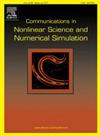LRBF-Based energy-conserving time splitting schemes for the 2D Maxwell equations
IF 3.4
2区 数学
Q1 MATHEMATICS, APPLIED
Communications in Nonlinear Science and Numerical Simulation
Pub Date : 2025-04-05
DOI:10.1016/j.cnsns.2025.108813
引用次数: 0
Abstract
In this paper, several energy-conserving numerical schemes are constructed for solving the two-dimensional Maxwell equations. Initially, the original problem is decomposed into two one-dimensional subproblems using operator splitting techniques. Subsequently, for spatial discretization, we employ the local radial basis function (LRBF) method, while for temporal discretization, three different splitting composition methods are selected, including the Lie-Trotter method, the Strang method, and the three-stage fourth-order splitting method. Through an analysis of the structural characteristics of the spatial differential matrices generated by the LRBF method, the unconditional stability and energy conservation properties of the fully discretized schemes are further proved. Numerical experiments validate the temporal convergence accuracy of the three numerical schemes and the preservation of their relevant properties.
基于lrbf的二维Maxwell方程的节能时分裂方案
本文构造了几种求解二维麦克斯韦方程组的节能数值格式。首先,利用算子分裂技术将原问题分解为两个一维子问题。在空间离散化方面,采用局部径向基函数(LRBF)方法,在时间离散化方面,采用Lie-Trotter法、Strang法和三阶段四阶分裂法三种不同的分裂构成方法。通过分析LRBF方法生成的空间微分矩阵的结构特征,进一步证明了完全离散方案的无条件稳定性和能量守恒性。数值实验验证了三种数值格式的时间收敛精度,并保持了它们的相关性质。
本文章由计算机程序翻译,如有差异,请以英文原文为准。
求助全文
约1分钟内获得全文
求助全文
来源期刊

Communications in Nonlinear Science and Numerical Simulation
MATHEMATICS, APPLIED-MATHEMATICS, INTERDISCIPLINARY APPLICATIONS
CiteScore
6.80
自引率
7.70%
发文量
378
审稿时长
78 days
期刊介绍:
The journal publishes original research findings on experimental observation, mathematical modeling, theoretical analysis and numerical simulation, for more accurate description, better prediction or novel application, of nonlinear phenomena in science and engineering. It offers a venue for researchers to make rapid exchange of ideas and techniques in nonlinear science and complexity.
The submission of manuscripts with cross-disciplinary approaches in nonlinear science and complexity is particularly encouraged.
Topics of interest:
Nonlinear differential or delay equations, Lie group analysis and asymptotic methods, Discontinuous systems, Fractals, Fractional calculus and dynamics, Nonlinear effects in quantum mechanics, Nonlinear stochastic processes, Experimental nonlinear science, Time-series and signal analysis, Computational methods and simulations in nonlinear science and engineering, Control of dynamical systems, Synchronization, Lyapunov analysis, High-dimensional chaos and turbulence, Chaos in Hamiltonian systems, Integrable systems and solitons, Collective behavior in many-body systems, Biological physics and networks, Nonlinear mechanical systems, Complex systems and complexity.
No length limitation for contributions is set, but only concisely written manuscripts are published. Brief papers are published on the basis of Rapid Communications. Discussions of previously published papers are welcome.
 求助内容:
求助内容: 应助结果提醒方式:
应助结果提醒方式:


